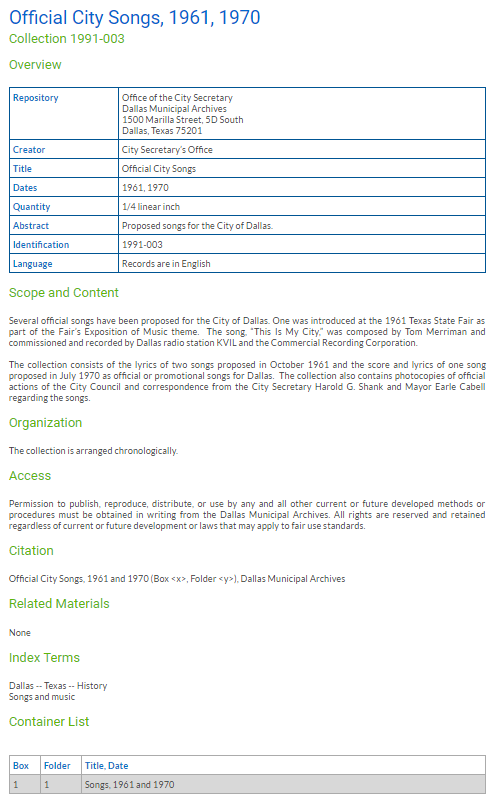Collection guides are tools that describe and detail the organization and contents of a collection. Archivists create them to enable you to
• navigate archival and manuscript collections
• establish a biographical or historical context for the collection
• describe the scope and contents of the collection
• specify the arrangement of the collection
• provide a list of boxes and folders within the collection
By browsing through collection guides, you can determine which parts of which collections you should look at for your research and ultimately help you save your own research and travel time.
Collection guides (also known as finding aids) share certain components, such as scope, index terms, and container list, no matter what institution you are visiting. At the Dallas Municipal Archives, the components of our collection guides are as follows. Use the Official City Songs screen shot shown below as a reference.
• Collection name and number—Shown in the heading information. In this case, "Official City Songs, 1961, 1970" is the collection name (which also includes the dates of the content); 1991-003 is the number.
• Overview—Shown in the table. In addition to repeating the collection name and number, the overview states the address of the Dallas Municipal Archives, the creator of the collection, the dates of the collection, the size of the collection, and the language of the collection. At this time, English is the standard language used by the collection.
• Scope and Content—Contains information to help you decide if the collection is relevant to your research. This section provides a summary of the content, describes the people, subjects, or places found in the records, and includes particular strengths or highlights of the collection.
• Organization—Describes how the collection contents are arranged. Arrangement is typically chronological but not always. NA means the collection only has one item or needs no arranging.
• Access—Describes both use agreement of Dallas Municipal Archives materials and copyright standards.
• Citation—Shows how the collection must be cited when used. Use the box and folder numbers of the item you are referencing. In this case, Official City Songs, 1961, 1970 (Box 1, Folder 1), Dallas Municipal Archives would be the correct citation. However, a larger collection might need to say Box 2, Folder 5. If you have any question about the citation contact a city archivist.
• Related Materials—Provides names and numbers of other collections in the Dallas Municipal Archives which a researcher might want to investigate.
• Index Terms—Offers other key terms for researching the topic.
• Container List—Provides a box- or folder-level inventory of the collection’s contents. This inventory includes the title, date, and sometimes more description of the contents. The container list and the scope and content areas are where you will learn the most about the collection. With that information, you can determine whether the collection will help you with your project. Occasionally, the list contains specific item numbers instead of folder numbers. The container list will also identify oversized materials (sometimes written OS), such as blueprints. These items are housed separately; the archivist will retrieve items when asked.
.